
21 minute read
Scholarship
Back in 2005, history professor Kristin Kobes Du Mez lectured on gender and how gender works in history. After class, a few male students told her she needed to read the book Wild at Heart by John Eldridge. So she did. The best-selling book encouraged Christian men to be warriors.
This idea intrigued Du Mez, and she continued to dig deeper into the history of gender in the evangelical tradition. The result is her recently released book, Jesus and John Wayne: How White Evangelicals Corrupted a Faith and Fractured a Nation. The book is a comprehensive history of masculinity in white evangelical culture. From a historical perspective, Du Mez examines the anti-communist crusade of the 1960s to the evangelical support of President Donald Trump.
Advertisement

“If we’re not actually understanding what has happened and perhaps where things have gone wrong, we will not be properly equipped to participate in the renewal of all things. This book doesn’t have all the answers, but it opens up a conversation,” said Du Mez. The book has received national and international media attention, and Du Mez has been interviewed by NPR and BBC Radio, among others.
Spark: What can someone expect to find in this book?
Du Mez: I described this as my book on white evangelical masculinity and militarism. … It is a work of Christian scholarship, and I am writing as a person of faith. [The subtitle “corrupted a faith”] is not actually a historical claim. It’s a kind of theological one.
I’m talking about how this embrace of a militant masculinity ends up transforming the faith itself. There are explicit cases where biblical passages, core teachings of the Bible— like love your neighbors as yourself, love your enemies, turn the other cheek—are explicitly rejected and thrown out. [When you believe the militant masculinity narrative,] you can’t teach a boy to be a man by teaching him to turn the other cheek. The Jesus of the gospels is literally transformed into a militant warrior Christ who has tattoos up and down his legs and rides on a horse, wielding a sword into battle to slay all his enemies … that’s the corruption that I’m talking about.
Why is it important to understand the histories of the cultures we are part of and acknowledge the unpleasant aspects of those histories?
As a Calvinist, I think that if we are just looking at the positive aspects of our tradition, that could be dangerous because we know that we are all fallen and that our institutions and our traditions also reflect our limitations. If we are not willing to investigate that and kind of excavate, we are going to be blind to the ways in which our traditions have caused harm in the past, have perpetuated perhaps abusive systems, have perpetuated injustices.
Once you define yourself as the good guys and whoever you’re opposed to as the bad guys, that’s when things get really dangerous, because then, almost by definition, whatever you do is righteous and whatever you do can be justified. The ends will justify the means because God is on your side. And this is exactly the language that we hear. And so, it becomes a very us-versus-them mentality. It’s not love your neighbor as yourself, or extending your hand to the other, the outsider, the stranger. It is seeing anybody on the outside as potential enemies, potential threats. Because if every man needs a battle to fight, well, you can’t fight a battle if you don’t have enemies.
What’s the response been to this book and to the provocative subtitle?
I was bracing myself. We live in a very polarized moment. One of the early reviews called [Jesus and John Wayne] an urgent and sharp-elbowed book. And I love that description. That was my intent. I’m not throwing punches at all, but there are some sharp elbows. And that was important to me, because through this research, I came to see how often a kind of culture of deference had facilitated abuses of power in churches, in organizations, in families.
The reception of the book has been enormously positive. I agree, I think it’s a provocative title. I’ve had conservative Christians thank me for that, because it says there is a Christian faith that is not this. That this is a corruption that we’re talking about and that there is redemption to be made. There’s a reformation. We can reform this, and that’s what we should be trying to do. And I love that that’s the way it’s landing with many readers.
For additional content with Kristin Kobes Du Mez, visit calvin.edu/spark.
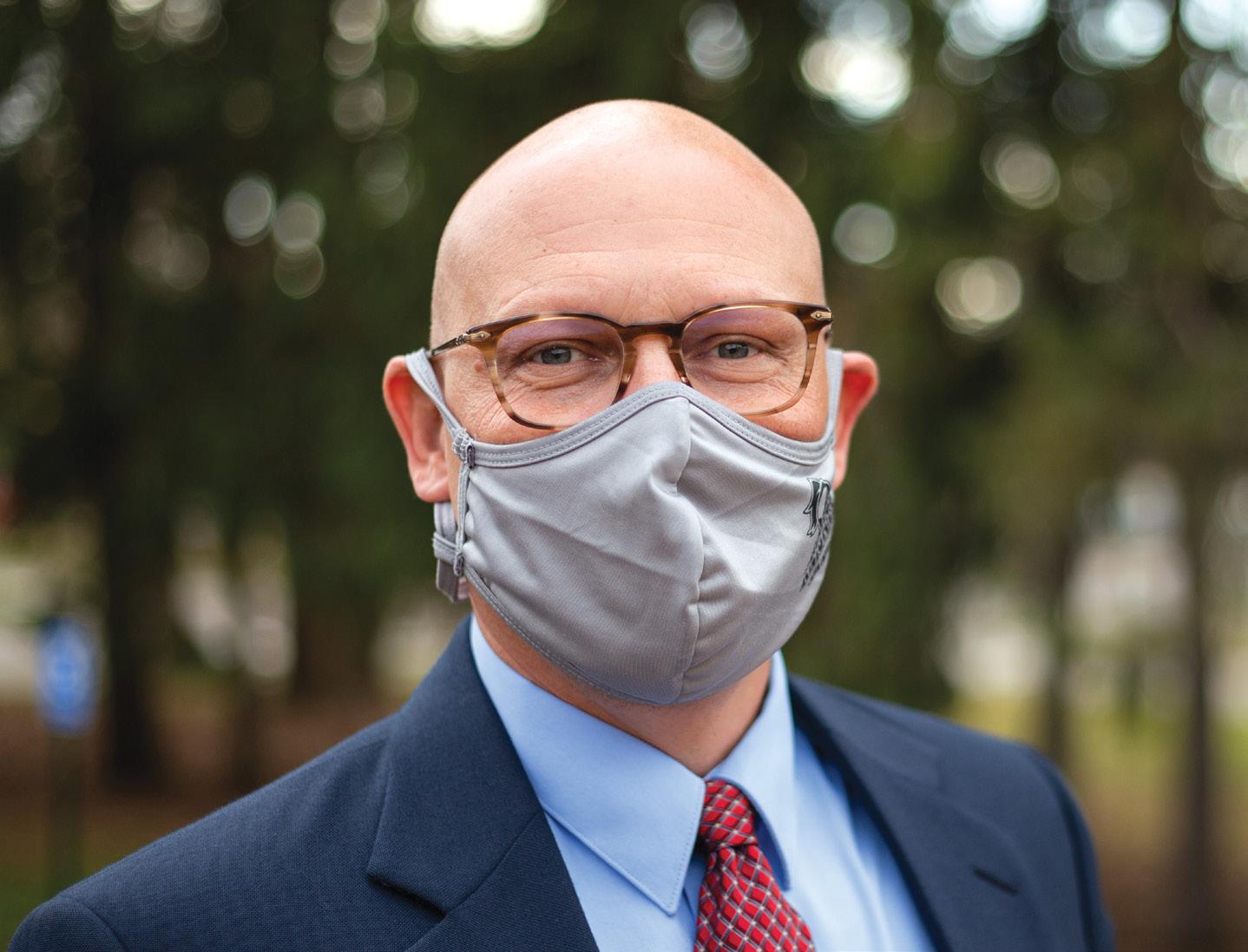
Tim Bergsma
Pearl Shangkuan Urban geography in Grand Rapids Jennifer Holberg
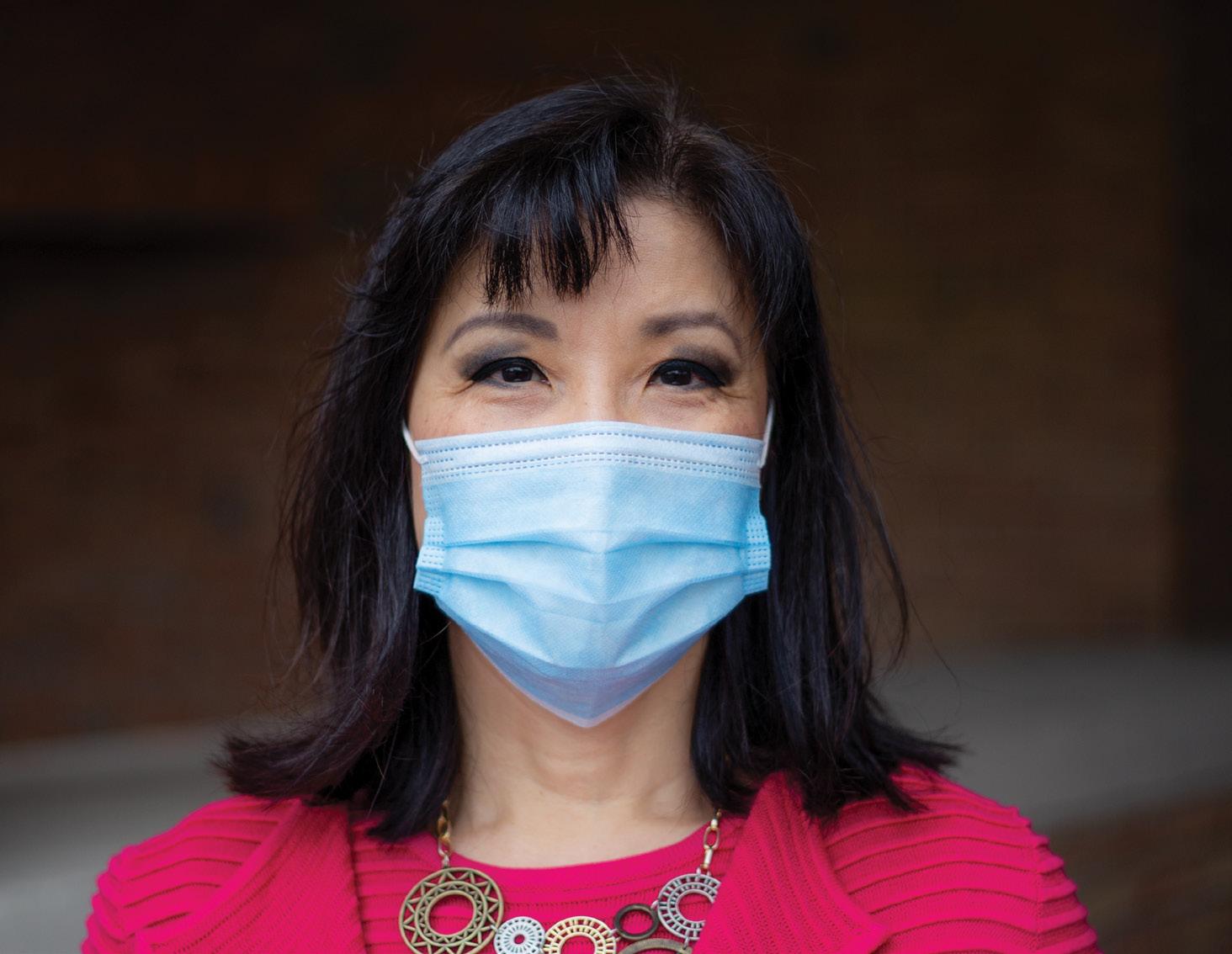


Leonard De Rooy
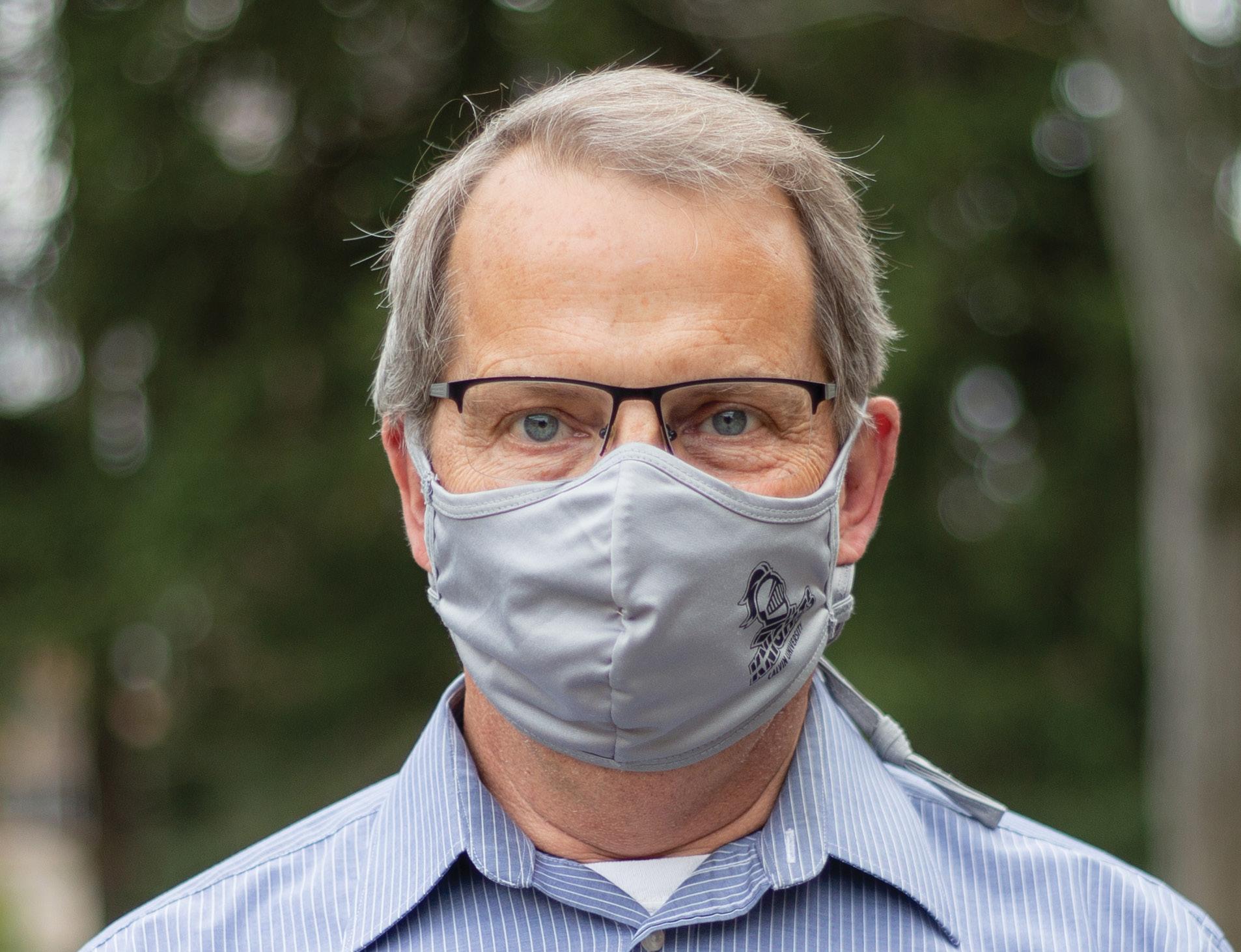
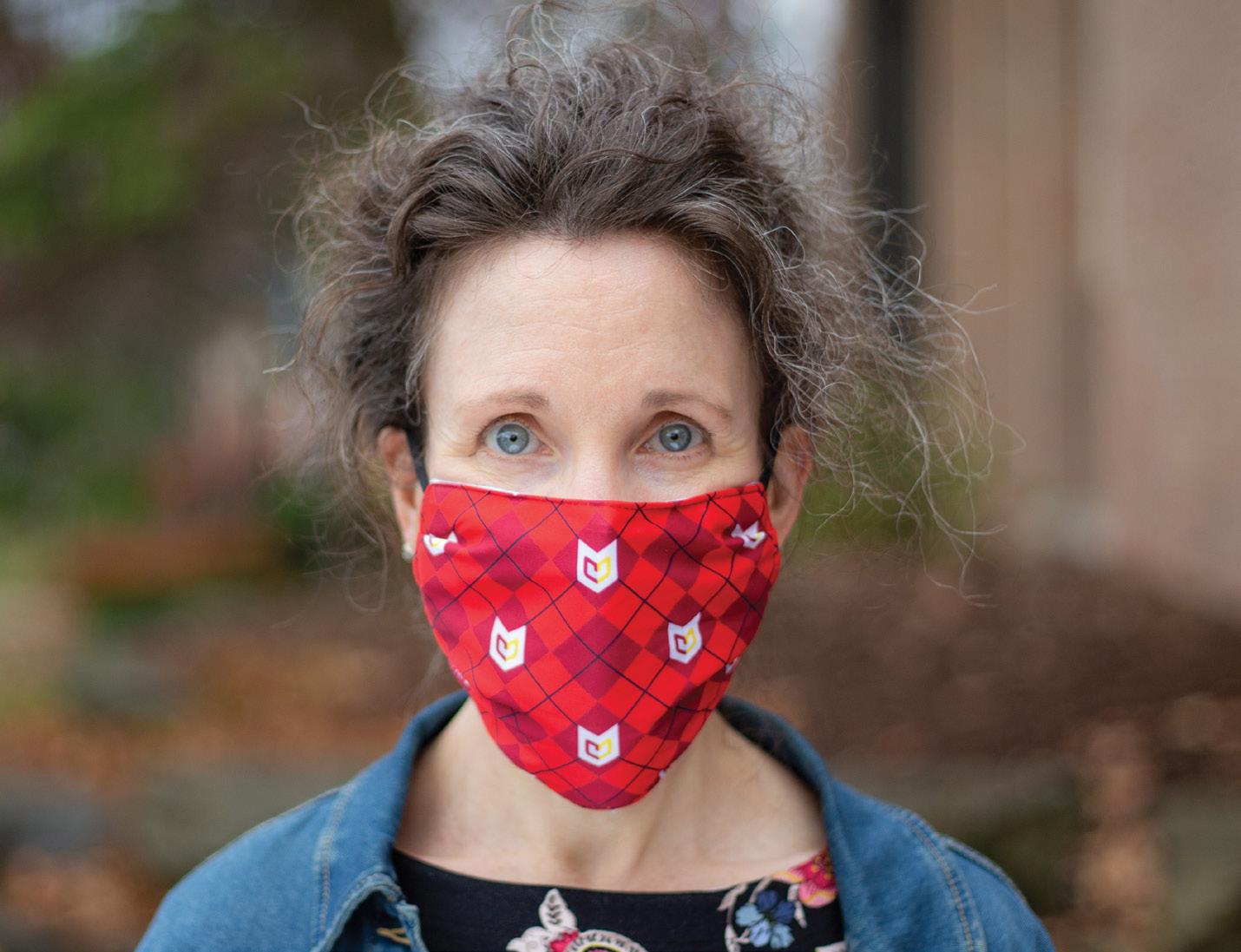
PROFESSORS OF THE PANDEMIC
Daunting. Draining. Logistically intense. These are some of the words Calvin’s faculty use to describe this semester. “It’s like running a marathon with the speed of a sprint while there’s an ongoing 6.8 earthquake,” said music professor Pearl Shangkuan, who’s been in such earthquakes.
The Calvin education experience hasn’t looked like this before. Yet, as you might expect, our professors are still doing what they do best—adapting, innovating, and above all, teaching.
REDEFINING ‘CLASSROOM’
To keep a class of students at the recommended six feet apart, you need space. Lots of it. This semester, classes are meeting in dorm basements, building lobbies, the Center Art Gallery, the Gezon, the Covenant Fine Arts Center auditorium, and other spaces on campus.
To complicate matters, faculty have students learning online in their classes. These online learners might be quarantined temporarily, choosing to learn online, or be international students who cannot leave their home countries. Some students connect in at class time. Students on the other side of the world might watch the class later. And professors have to make sure all students are engaged and progressing academically.
“We’re effectively teaching three classes in one,” said English professor Jennifer Holberg, who has students as far away as Indonesia and South Korea. “And that takes a ton of work to do well. I’ve seen things in the media questioning the quality of education during the pandemic. At Calvin, I am confident that we are continuing to give students the very best we can, even as it is asking that all the faculty give 200%.”
WHAT THAT 200% LOOKS LIKE
When faced with these extraordinary constraints, faculty started brainstorming solutions and working together. Calvin Information Technology set up internal listservs where professors crowdsourced ideas and helped each other with problems.
Engineering professor Leonard De Rooy wanted his students learning online to see his diagrams and his body language. “I created a recording studio at my home that has a green screen and several cameras. I had one camera pointing to my tabletop that recorded what diagrams and calculations that I wrote,” he said. “At the same time, I had a camera pointing to my face and using a green screen feature, I was able to superimpose my face on top of my tabletop recordings.”
In Mark Bjelland’s urban geography class, students normally take a city bus or a 12-passenger van to explore different parts of Grand Rapids. “Once Calvin’s social distancing guidelines were released, I realized I needed to come up with an alternative approach.” His solution? Bicycles. He spent the summer finding helmets, bikes, and safety lights for his class. It’s worked out so well, he plans to incorporate some biking into his teaching post-COVID.
“On a bike, you can see neighborhoods up close, hear children’s voices, and go places cars can’t go,” he said.
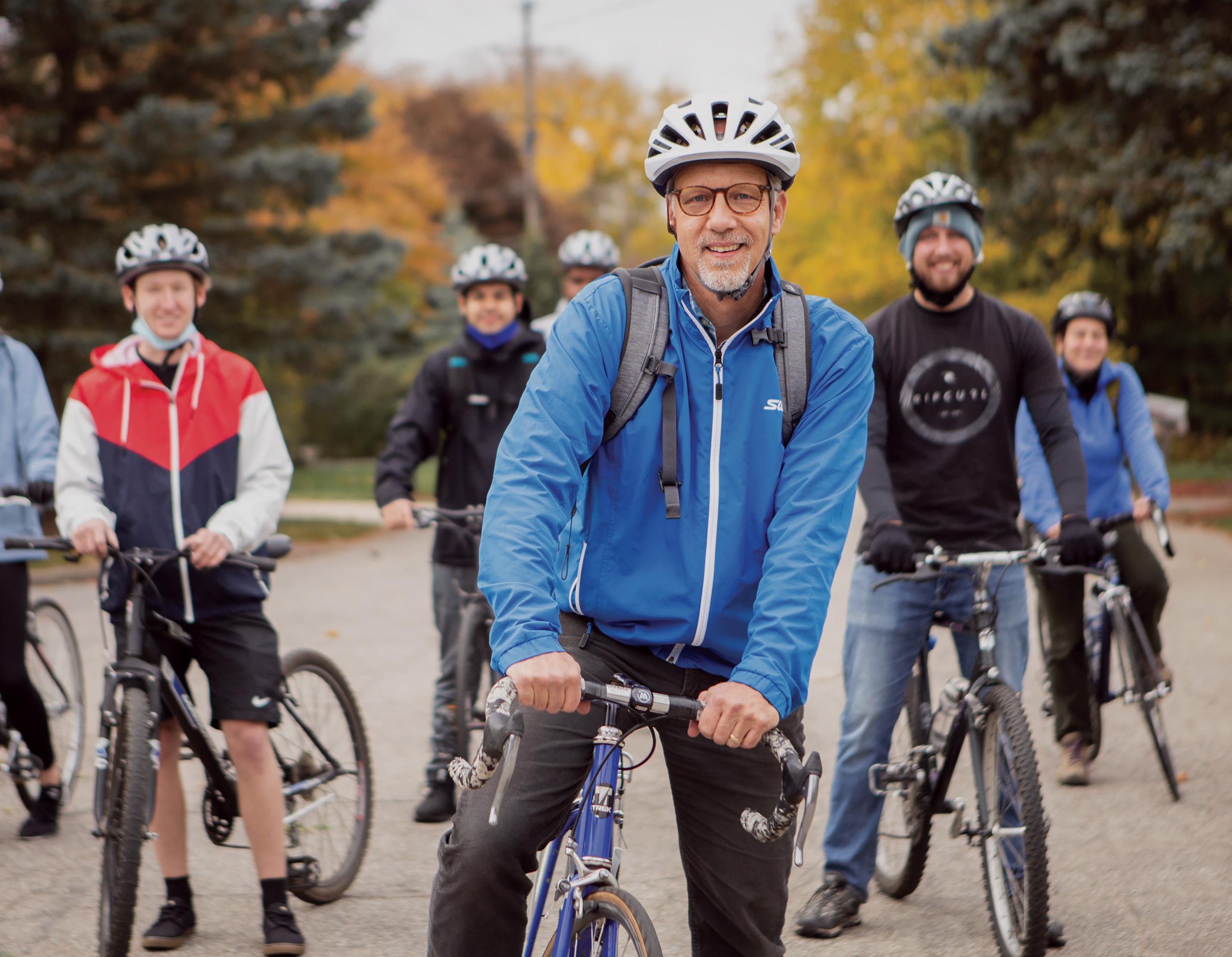
PEARL SHANGKUAN, MUSIC
Professor Pearl Shangkuan’s discipline, choral singing, presented unique challenges during the pandemic. For months, she studied research on droplets and aerosols. How could her students continue to sing together—and be safe? Using the guidelines provided by national music organizations, she and Calvin’s Safe Return Team made a plan. The singers wear special singing masks at rehearsals and sing at least six feet apart. They use larger facilities like the University Chapel to rehearse with smaller groups of students spread out. “The day when each of my ensembles first sang, I asked them to pause and ‘click save’ to remember and treasure this moment we had all been waiting to hear for six months. At times, we didn’t know if it would even happen. Being able to sing together is essential to our spirit. It’s a gift and privilege we’ll never, ever take for granted again.”
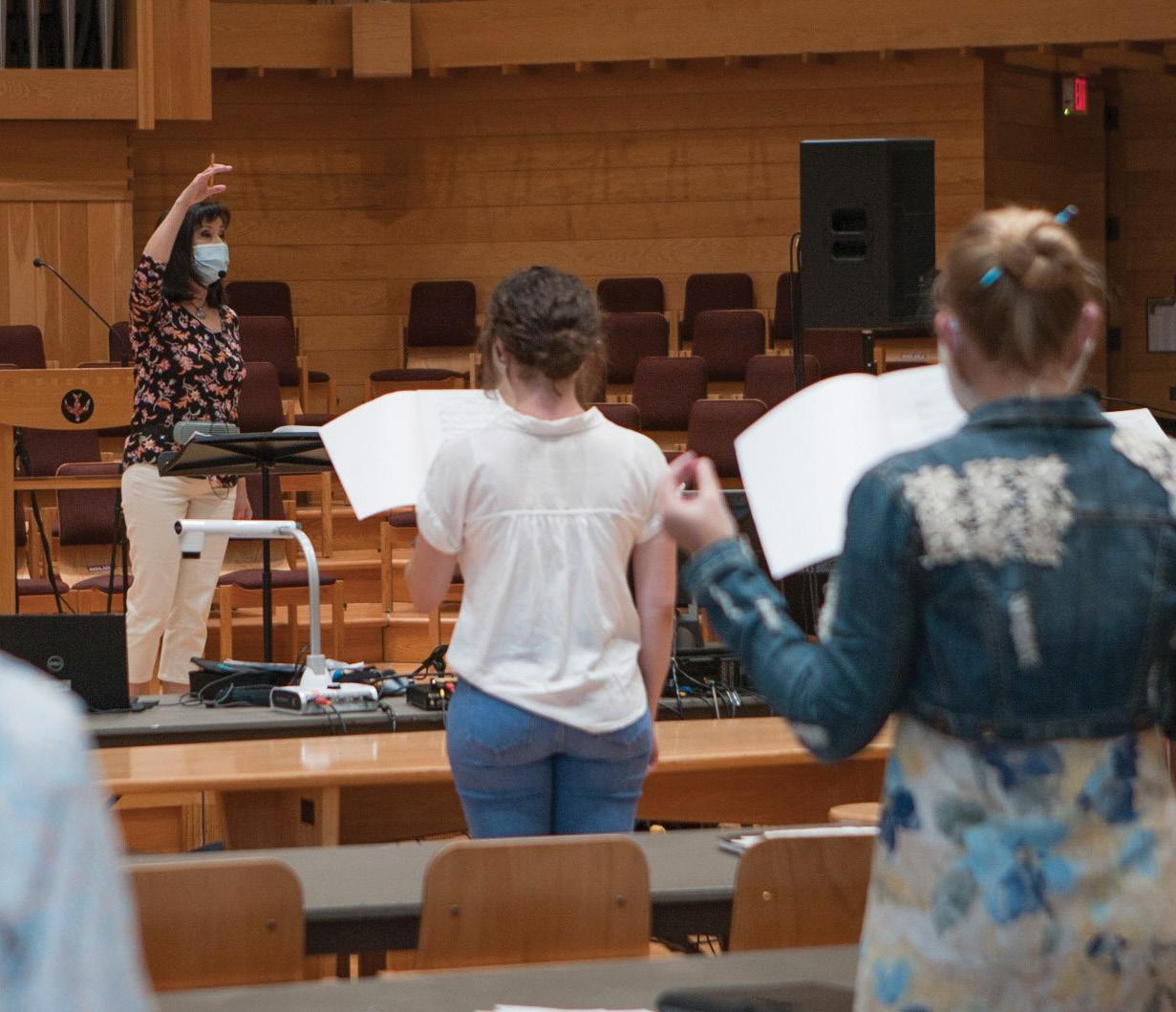

—CATHERINE WORTHINGTON JUNIOR SPANISH MAJOR
DAVID DORNBOS BIOLOGY
David Dornbos has been teaching biology at Calvin since 2004, but never like this. He’s decided to “flip” his classroom. Before class, students do the reading and watch Dornbos’ recorded lectures. Then they use their class time to ask questions and dig deeper into the material, sometimes quite literally. For the first few months of the fall semester, the class has been meeting outdoors in the Calvin Community Garden.
“How we learn is different in key ways than in previous years, learning is definitely happening. And in fact, more learning may be happening by engaged students. Touching, seeing, and tasting practical examples in the Calvin Community Garden makes concepts previously constrained to a classroom more real, reduces cognitive load, and engages the visual learner in ways not possible before.”
ALISA TIGCHELAAR SPANISH
Spanish professor Alisa Tigchelaar makes sure to welcome “los amigos remotos” each class period. In one of her classes, she can only have 75% of students physically there at once because of the room size. They are making due, and Tigchelaar is reminding her students (and herself) to focus on the blessings and overlook the small challenges they face.
“Today we recited the Lord’s Prayer all together, and the remote students had their mics on. It was beautiful noise to hear five remote voices crackle over the speaker and the rest in person, all of us slightly off. I pointed out that God hears us all: our asking for bread and forgiveness and to be guided in his ways, in spite of what might seem incomprehensible to us. He hears us during COVID, too.”
TIM BERGSMA BUSINESS
This spring, a few weeks into the abrupt change to online learning, Tim Bergsma sent his students an informal survey. He wanted to know, directly from them, about the obstacles they were facing. He learned his well-intentioned, dense emails were overwhelming to students, but that they craved connection and accountability. Considering the limitations and the available tools, he changed his tactics and was impressed with the results. “The virtual space allowed me to connect with students that normally wouldn’t talk with me outside the classroom,” he said.
“At Calvin, we pride ourselves on equipping our students to address complex problems with creative and critical thinking. And we find ourselves square in the middle of a really complex situation that demands creative problem solving. In a sense, we’re living out in real time a case study.”
I couldn’t be more pleased to see

DID COVID-19 KILL THE CLASSROOM?
BY MICHAEL K. LE ROY
PRESIDENT
As Calvin’s president, I am often asked whether I believe that traditional classroom learning at the university level is obsolete. I do not. But declarations from pundits, far removed from the student experience, have wrongly declared the death of the traditional classroom.
In the midst of this pandemic, I began a practice of weekly office hours with students. We gather online in small groups, and I invite them to share an experience, propose a topic for discussion, or ask a question about Calvin University. These times together have been wonderful.
One of the most important insights I have gained from these conversations is how deeply our traditional residential students yearn for the experience of community-based incarnate learning. The students describe the value of relational learning from professors and one another, discussion and debate with nuance and passion, and the chance encounters with students, staff, and faculty.
I received an article co-published by Calvin alumni Peter Boumgarden ’05 and Abram Van Engen ’03. A key observation I appreciated is the identification of the physical energy required to attentively listen. This is a hard task under the best of circumstances, but the temptation to “check out” is far greater in Zoomworld. “[There is a] communal aspect of attentiveness crafted by coming together in a shared space,” they write. “When the speaker is in the same room with you, maybe even right beside you, the sense of listening—and the importance of speaking—each becomes elevated.”
Attentiveness is really hard work. Most teachers who have taught in a traditional classroom notice when it is being practiced and notice when it is absent. In the virtual classroom, or any virtual meeting, the distractions and temptations are ubiquitous. I know this because I too have succumbed to the siren song of some notification going off on my screen.
I expected traditional teachers to miss the physical classroom, but the most pleasant surprise to me is how much the students miss it. Our return to in-person learning has been a joy for all of us.
This pandemic occasion has also caused many thoughtful, creative traditional teachers to cross the Rubicon into online teaching and instructional design. These faculty love their students, however they choose to learn, and are committed to making their virtual courses a worthy academic experience. I would never have wished the challenges of this season on my colleagues but, as an administrator, I couldn’t be more pleased to see the application of such considerable academic talent devoted to delivering excellent learning in new ways. Millions of nontraditional graduate and undergraduate students, working full time and tending to family and other responsibilities, find the convenience of online learning to be the best pathway to achievement of academic and career goals. New insight, new talent, and new adversities almost always advance knowledge, so this season is indeed promising for nontraditional students, and likely beneficial in some innovative ways for all students.

As this season enhances virtual learning, we must also remember how much the traditional classroom is missed by those students who must go without it. And as Calvin ramps up new online academic programs, we must remember to apply the lessons we take for granted in our physical life together.
To read the article “In Praise of Classrooms” by Peter Boumgarden and Abram Van Engen, visit calvin.edu/spark.
ADMITTEDLY COMPLEX
THE NEW PLAYBOOK IN UNDERGRADUATE ADMISSIONS
Last year at this time, Isaac Seiler was collecting college acceptance letters. The Rockford, Michigan, student applied to 11 colleges, all across the country, and the acceptance packets kept rolling in. “It was kind of overwhelming,” he said. His mailbox overflowed. Colleges sent him handwritten notes, glossy posters, and trinkets emblazoned with logos. He scrutinized virtual tours and had long conversations with friends and family.
Ultimately, Seiler chose Calvin. When he reflects on his decision, he can’t pinpoint one reason for his choice. He recalled a memorable Fridays visit, getting accepted into the Honors Scholars program, and an aid package that was competitive and made Calvin financially feasible.
Seiler’s story is a common one. “The competition in undergraduate recruitment is increasing, and there are many factors students and families consider,” said Lauren Jensen, vice president of enrollment strategy. “People often think that if we just did this one thing, we could tip a student to decide, but the recruitment landscape and decision-making process is very complex.”
BY SARAH POTTER JOHNSON ’00
—LAUREN JENSEN
VICE PRESIDENT OF
ENROLLMENT STRATEGY
MOVING FROM MANAGEMENT TO STRATEGY
Every morning, Jensen inspects that complicated landscape. Her phone flashes the latest dashboard of data that Calvin is tracking—applications, visits, “pings” on the website, and more. She’s looking for insight and opportunities.
“We can’t set an enrollment management plan and assume that the students will come,” said Jensen, who had been in the vice president role for only a year when the pandemic hit. “We need to be much more strategic about the use of our resources—everything from where we spend our financial aid dollars to what schools we send our admissions counselors to, to how we invest in digital advertising.”
Jensen points out that Calvin has taken this “data-driven strategy” approach in student retention in recent years—and it’s been working. After a few years of declining retention rates, Calvin assessed, evaluated, and made important changes that improved the retention rate from 84.6% to 86.8%.
A HARD LOOK AT THE HARD NUMBERS
When students were counted on census day this fall, the total Calvin University enrollment was at 3,307. There were 805 new incoming students, many moving into the residence halls, meeting new friends, and navigating the crisscross paths of campus for the first time.
If those numbers seem low to you, you’re not alone. In 2013, Calvin’s incoming class was 1,107, and the number of incoming students has been steadily shrinking since then.
This year has been especially difficult for colleges and universities as a whole, with many students deferring a college education. According to the National Student Clearinghouse Research Center, the United States saw a decline in freshman enrollment this year of 16.1%. Michigan higher ed institutions saw a drop of 9.5% in undergrad enrollment in 2020. Students also tended to stick closer to home this fall, opting to go to college in their home states. Calvin has large populations of out-ofstate and international students, said Jensen, so it might have been more adversely affected by that trend than other institutions. Calvin’s percentage of in-state students is up this year (54% in 2020 compared to 52% last year).
Jensen is quick to point out that demographic factors aren’t the only reason Calvin’s enrollment numbers are going down. “We can—and do—spend a lot of time looking back and analyzing what happened the prior year. We survey students about why they enrolled or didn’t enroll at Calvin, we analyze trends, and we listen to anecdotes,” Jensen said. “And taking all that into consideration, we make a strategy that will hopefully enable Calvin to grow and expand in new networks and places.”
NEW ADMISSIONS DIRECTOR
For Melissa Rousseau, it’s all about the question “why.” She asks that question a lot in her role as the director of admissions, a job she started in July.

“When you understand why and your team understands why, you can move toward the end goal together,” Rousseau said. Her end goal right now? Meeting the enrollment targets for the next class of Calvin Knights.
It’s a challenge she is up for. Rousseau is not new to the demands of higher education. She comes to Calvin with 19 years of experience at Davenport University. While she was at Davenport, that university underwent a lot of change, consolidating 36 campuses into 11.
“I had really wide experience there,” said Rousseau, who has experience in admissions leadership, marketing, financial aid, and student services. She also brings knowledge of reaching different audiences, like adult learners and transfer students.
Rousseau said she’s been encouraged by Calvin’s leadership to share her fresh perspective. “I’m looking at everything from billboards on the highway to our visit presentations, and I’m asking lots of questions about our goals and results.”
A CHANGING PLAYBOOK
High schoolers this year are facing travel restrictions, cancelled college fairs, and uncertainty about the economy. “In the COVID reality, the admissions playbook gets to be rewritten,” Jensen said. “This is a time for those of us who can think creatively about new approaches.”
One of the first things the admissions team reconsidered was the college visit. Instead of offering large one-size-fits-all visit days like Fridays at Calvin, Calvin changed course. Now, students can choose from “bite-sized” sessions with lots of virtual options.
“We have an entirely new perspective on events,” said Melissa Rousseau, director of admissions. “We’re giving students the opportunity to engage with us multiple times throughout the year. We want to deliver the information that they want exactly when they want it.”
In the fall, prospective students could visit campus in person. Plus, they can join virtual events like Open House Live and Career Pathways. “We’re taking advantage of the online platform to deliver some unique and unexpected experiences,” said Stephanie Brink, associate director of admissions.
Another part of the strategy is to grow awareness of Calvin through digital campaigns. “We’ve revamped our approach this year to be more focused and targeted in our efforts with email and digital marketing,” said Rousseau. Data also informs which schools the admissions counselors target. “We have data on schools across the country, and we can see where we might gain some traction,” said Robin Wait, associate director of admissions.
WORLDWIDE INFLUENCE
In the last six years, one segment of Calvin’s population has grown: international students. “We made a real commitment to grow,” said Tara Braun, director of international admissions. An additional international recruiter was hired, and Braun’s team built global connections.
Alumni in places like Ghana and South Korea build Calvin’s reputation through their networks. In recent years, Calvin’s international student body has been about 13%.
In the spring, consulates were closing, and it seemed impossible for some international students to study at Calvin in the fall. “We knew we needed to do something,” said Braun, who worked with a cross-divisional team on a plan. “I’m proud of how we came together to make it all happen,” she said.
In the end, they were able to pivot to an online cohort and retain 101 incoming international students this fall, with more coming in the spring. “A lot of other institutions just lost their international students,” Braun said. “We couldn’t let that happen.”
5
Practical Ways Alumni Can Help Calvin Grow
REMEMBER YOUR CALVIN STORY
“There’s power in your story as an alum,” President Michael Le Roy told alumni on a Facebook Live video this fall. When the topic of your college experience comes up in conversation, be ready to tell how your Calvin education shaped your life.
BE BOLD ABOUT SHARING
Follow Calvin on social media, and hit the share button when you see good news. There are great things happening at Calvin, and you never know what might connect to a prospective family.
USE YOUR NETWORKS
It might feel more natural to talk about Calvin with others who are already familiar. But think about ways you can introduce Calvin into other circles of your life, like including Calvin in your professional bio or wearing Calvin gear to a neighborhood gathering.
GET A BUMPER STICKER
Show your Calvin pride with a new Calvin University Alumni sticker for your car. Email alumni@calvin.edu with your address, and we’ll drop one in the mail.
RECOMMEND CALVIN
If you talk to a high school student about Calvin, tell us about it at calvin.edu/recommend.
If you’d like to help admissions efforts in your area, email admissions@calvin.edu. The admissions team will let you know when there is an event or initiative in your area.
THE CALVIN PROMISE
Cost is a big issue in the college decision-making process. And the financial aid process can be daunting or unknown to many families. There’s also trepidation about the amount of financial aid changing over time.
That’s where the Calvin Promise comes in. The program launched this fall and assures prospective students that they will receive at least $21,000 per year for four years if their weighted high school GPA is 3.8 or higher.
“We know that many more families are experiencing financial difficulties this year and that may continue for some. The Calvin Promise offers some assurance of stability to families,” said Paul Witte, director of financial aid.
The Calvin Promise combines scholarships and grants based on the student’s academic record, background, and financial need for a combined $21,000 per year for qualified students.
Even if students don’t meet the GPA requirement for the Calvin Promise, Calvin considers each student as an individual when creating an aid package that often includes an academic scholarship, need-based grants, and other scholarships and awards. Children of alumni receive a $4,000 legacy award that automatically renews each year.
For more information and a complete list of qualifications, visit calvin.edu/promise.

